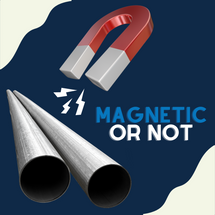Posted by PipingNow.com on Feb 10th 2022
STAINLESS STEEL – MAGNETIC OR NOT?
There is a common but incorrect belief that the Chromium-Nickel or Chromium-Nickel-Molybdenum stainless steel must be “non-magnetic” to be corrosion resistant. This misconception is sometimes carried through another step wherein “reasoning” says that a magnetic material cannot be stainless steel.
There are many alloys within the general family of corrosion resistant or “stainless” steels. Some of these alloys are very resistant to chemical attack and at the same time are quite “magnetic”.
Where stainless castings are involved, the most important factor controlling magnetic properties is the chemical composition; that is, the percentage of the various elements present in the material. The ASTM specifications for various stainless alloy castings are intended to produce sound castings with good corrosion resistance, but these castings will not necessarily be non-magnetic.
ASTM A351, Grade CF8M (316 cast equivalent) is one of the stainless alloys that is likely to be somewhat magnetic. Stainless steel derives much of its corrosion resistance from a certain minimum amount of chromium dispersed uniformly throughout the material. In castings it is common foundry practive to add extra chromium to assure that all areas will contain at least the minimum required for corrosion resistance. This extra chrome, plus molybdenum both tend to enhance the formation of an iron-chromium complex call Ferrite. Ferrite is very hard and adds to the strength of the casting. For this reason, many foundries purposely control melt composition to assure that some ferrite is formed. Ferrite is also magnetic, and the casting will be magnetic to a degree dependent upon the amount of ferrite formed.
In material intended for extrusion, hot rolling, forging, cold heading, etc. the ASTM specification again allows for a composition intended to produce the most desirable material. Somewhat more nickel and less chrome are used, which reduces the amount of ferrite formed. This “wrought” version of 316 may have a structure that is completely ferrite-free and non-magnetic. However, when this alloy is formed or “worked” by forging, rolling, stamping, etc., a phenomenon called Work Hardening takes place. The material becomes harder, stronger, and more magnetic. Heating (annealing) will remove the magnetic property along with part or all the extra strength previously gained by working. In most valve parts a degree of extra hardness is desirable, so again the parts may show some attraction to a strong magnet.
Quite obviously then the “magnet test” will not separate stainless from carbon steel unless some precautions are observed. A sample od soft carbon steel should be used to compare with the unknown. The stainless material may be magnetic when a strong magnet is used, but a significant difference will be noted when the magnet is touched to carbon steel. This difference will be noted when the magnet is touched to carbon steel. This difference would be used rather than the presence or absence of a magnetic property.
Of course, a PMI (Positive Material Identification) is a fast, non-destructive, and preferred method to determine the actual type of metal.

